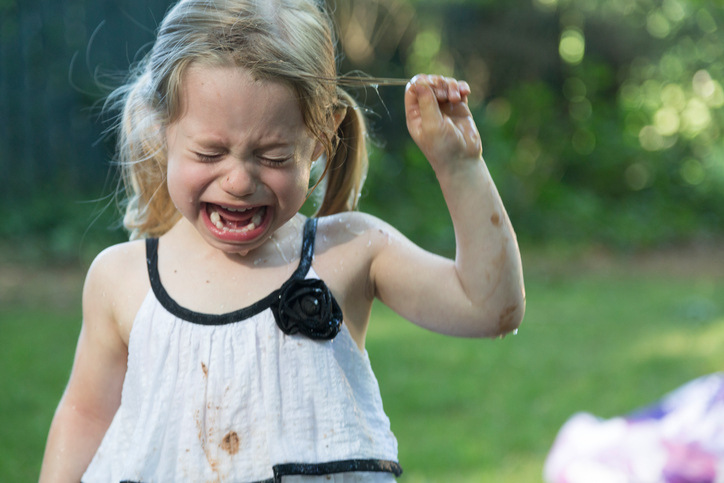Developmental ResourcesDiscipline Resources
Temper Tantrums

Aggressive children can cause major parental stress! Parents are often at a loss to know what to do when their child hits, spits, bites, screams, or has a major temper tantrum in a public place. Children use temper tantrums to achieve a purpose. There are basically 4 types of tantrums:
- Your child is tired or frustrated
- They want attention
- They are reacting to your “No”
- They don’t want to obey you

When you deal with the purpose behind the tantrum, the outbursts will significantly decrease. Don’t be intimidated by these aggressive outbursts, but resolve to deal with them quickly and directly. Here are some ideas to help you do this.
Observe your child for a few days to discover a pattern to their tantrums. The pattern might reveal the purpose.
- When do they occur? Is there a time of day when they are more frequent? For example, if the tantrum is usually before dinner, it could be that their hunger is firing them up!
- What was happening at the time?
- What did you do?
- How long did it last?
- Who is usually present when they have their meltdown? Some children are quite selective in choosing their audience.
How To Respond
Anger is a normal response in children. But while anger is not a ‘bad’ emotion, how it gets expressed might well be! The real secret is to empathise and validate your child’s frustration and anger, whilst setting boundaries around how it gets expressed: “Sally, Dad knows you want a toy, and that you are cross you can’t have one. That’s okay. But you are not to kick and yell.”
Preventing temper tantrums
Tired or frustrated tantrums.
Tired and hungry kids get grumpy! Growing up takes a lot of energy so be sure your child gets attention in these areas. Make sure they are fed and rested before going out. If you know you’ll be waiting in long queues (like at the bank), take along your child’s favourite toy for them to play with.
Attention temper tantrums.
If you think the purpose of your child’s tantrum is attention seeking, ignore their tantrums. They will yell and kick harder, but if you ignore them, they’ll soon believe that tantrums don’t work because “No one notices me when I do it.”
Power struggle temper tantrums.
The key to dealing with defiance tantrums is to understand what is occurring within your child, not just focus on their obnoxious behaviour. Parents can react to temper tantrums by pushing away their child – either physically or emotionally. But your child is giving a cry for help. The temper outburst is their way of saying something isn’t right. While it’s hard to draw close and reason with a child in the middle of a tantrum, realise your child is running low in their energy bank account. Nurturing love is what fi lls up your child’s energy bank account.
See our article on Raising a Co-operative Child for ideas on how to help children deal with their frustrations so they aren’t expressed in uglier ways.
Stopping tantrums
- Don’t react with anger, or give in to a child having a temper tantrum. Shaming, blaming, or humiliating your child only intensifies the power struggle. During a tantrum, don’t try and reason with your child. Wait until there is peace again before you talk reason with your child.
- Gain your child’s attention by stopping what you are doing and moving closer to him.
- Tell your child that the crying, screaming, or kicking must stop or he will be sent to time-out: “Johnny, stop yelling and talk quietly. If you don’t stop you’ll be sent to time-out.”
- If they stop, encourage and thank them. If tantrum continues send him to time-out. While in time-out have no contact till he is quiet. Do this even if all hell let’s loose! And it well might if you have previously maintained contact with them while they are in time-out. Time out is only effective if you put on hold all contact until they are quiet. Time out continues until your child has been quiet for at least a minute.
- If your child has a tantrum in a public place use the same process:
a) Don’t be embarrassed! If people give you the ‘stares’, they have forgotten what their child used to do.
b) For time-out, remove child to a quiet place in the store. If he still continues, take him out of the store to your car . . . and if he won’t walk, carry him! Look him in the eye and say, “You’re out of control. I’m in control. I understand you’re upset because you want that chocolate bar but there are reasons you can’t have it. Until you calm down, you’re going to sit here.” - When your child calms down give him a hug and say, “I’m glad you’re calm now”. Don’t mention the tantrum. Give your child extra attention when he’s co-operating.
Final thought
Children are more likely to co-operate if they know what is expected. Discipline always works best if you involve your child in setting limits before misbehaviour occurs. And part of setting limits is sharing with your child the consequences if they misbehave. When you set consequences, you will react less impulsively when your child misbehaves. Impulsive reactions often punish you more than your child: “I’m not going to take you shopping” . . . which translates, “Blow, now I can’t go shopping either”!
Further reading:
Every Parent: A Positive Approach to Children’s Behaviour, by Dr Matthew Sanders (Addison-Wesley Publishing Company, 1992).
 Like and follow us on FACEBOOK to stay up to date with parenting research
Like and follow us on FACEBOOK to stay up to date with parenting research



